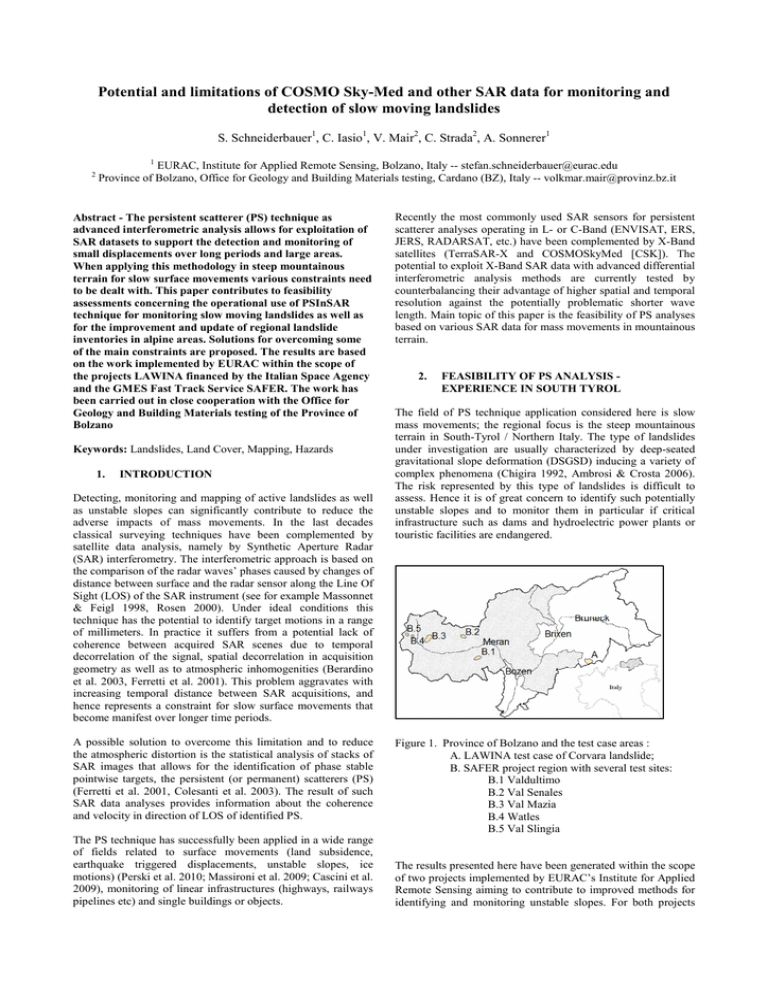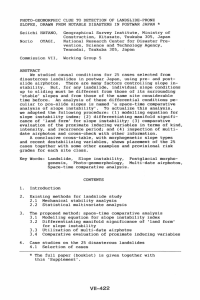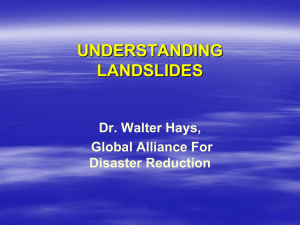Potential and limitations of COSMO Sky-Med and other SAR data... detection of slow moving landslides
advertisement

Potential and limitations of COSMO Sky-Med and other SAR data for monitoring and detection of slow moving landslides S. Schneiderbauer1, C. Iasio1, V. Mair2, C. Strada2, A. Sonnerer1 1 2 EURAC, Institute for Applied Remote Sensing, Bolzano, Italy -- stefan.schneiderbauer@eurac.edu Province of Bolzano, Office for Geology and Building Materials testing, Cardano (BZ), Italy -- volkmar.mair@provinz.bz.it Abstract - The persistent scatterer (PS) technique as advanced interferometric analysis allows for exploitation of SAR datasets to support the detection and monitoring of small displacements over long periods and large areas. When applying this methodology in steep mountainous terrain for slow surface movements various constraints need to be dealt with. This paper contributes to feasibility assessments concerning the operational use of PSInSAR technique for monitoring slow moving landslides as well as for the improvement and update of regional landslide inventories in alpine areas. Solutions for overcoming some of the main constraints are proposed. The results are based on the work implemented by EURAC within the scope of the projects LAWINA financed by the Italian Space Agency and the GMES Fast Track Service SAFER. The work has been carried out in close cooperation with the Office for Geology and Building Materials testing of the Province of Bolzano Keywords: Landslides, Land Cover, Mapping, Hazards 1. INTRODUCTION Detecting, monitoring and mapping of active landslides as well as unstable slopes can significantly contribute to reduce the adverse impacts of mass movements. In the last decades classical surveying techniques have been complemented by satellite data analysis, namely by Synthetic Aperture Radar (SAR) interferometry. The interferometric approach is based on the comparison of the radar waves’ phases caused by changes of distance between surface and the radar sensor along the Line Of Sight (LOS) of the SAR instrument (see for example Massonnet & Feigl 1998, Rosen 2000). Under ideal conditions this technique has the potential to identify target motions in a range of millimeters. In practice it suffers from a potential lack of coherence between acquired SAR scenes due to temporal decorrelation of the signal, spatial decorrelation in acquisition geometry as well as to atmospheric inhomogenities (Berardino et al. 2003, Ferretti et al. 2001). This problem aggravates with increasing temporal distance between SAR acquisitions, and hence represents a constraint for slow surface movements that become manifest over longer time periods. A possible solution to overcome this limitation and to reduce the atmospheric distortion is the statistical analysis of stacks of SAR images that allows for the identification of phase stable pointwise targets, the persistent (or permanent) scatterers (PS) (Ferretti et al. 2001, Colesanti et al. 2003). The result of such SAR data analyses provides information about the coherence and velocity in direction of LOS of identified PS. The PS technique has successfully been applied in a wide range of fields related to surface movements (land subsidence, earthquake triggered displacements, unstable slopes, ice motions) (Perski et al. 2010; Massironi et al. 2009; Cascini et al. 2009), monitoring of linear infrastructures (highways, railways pipelines etc) and single buildings or objects. Recently the most commonly used SAR sensors for persistent scatterer analyses operating in L- or C-Band (ENVISAT, ERS, JERS, RADARSAT, etc.) have been complemented by X-Band satellites (TerraSAR-X and COSMOSkyMed [CSK]). The potential to exploit X-Band SAR data with advanced differential interferometric analysis methods are currently tested by counterbalancing their advantage of higher spatial and temporal resolution against the potentially problematic shorter wave length. Main topic of this paper is the feasibility of PS analyses based on various SAR data for mass movements in mountainous terrain. 2. FEASIBILITY OF PS ANALYSIS EXPERIENCE IN SOUTH TYROL The field of PS technique application considered here is slow mass movements; the regional focus is the steep mountainous terrain in South-Tyrol / Northern Italy. The type of landslides under investigation are usually characterized by deep-seated gravitational slope deformation (DSGSD) inducing a variety of complex phenomena (Chigira 1992, Ambrosi & Crosta 2006). The risk represented by this type of landslides is difficult to assess. Hence it is of great concern to identify such potentially unstable slopes and to monitor them in particular if critical infrastructure such as dams and hydroelectric power plants or touristic facilities are endangered. Figure 1. Province of Bolzano and the test case areas : A. LAWINA test case of Corvara landslide; B. SAFER project region with several test sites: B.1 Valdultimo B.2 Val Senales B.3 Val Mazia B.4 Watles B.5 Val Slingia The results presented here have been generated within the scope of two projects implemented by EURAC’s Institute for Applied Remote Sensing aiming to contribute to improved methods for identifying and monitoring unstable slopes. For both projects the analysis of the SAR scenes has been realized by Telerilevamento Europa (T.R.E.) using their in-house developed Permanent Scatterers Technique (PSInSAR™ and SqueeSAR™). on DS with an accuracy similar to that obtained with the help of PS. The first project LAWINA, (LAndslide detection and WIndfall Assessments based on CSK X-band data) is financed by the Italien Space Agency (ASI) and evaluates the usefulness of XBand data for monitoring deep-seated slow landslides. Test site is a wide and complex landslide close to Corvara, a small touristic town in the Dolomites (see A in Figure 1). The second project SAFER, “Services and Applications For Emergency Response”, is financed by the European Commission’s FP7. Within the context of SAFER EURAC supports the update of the existing landslide inventory for the Western part of SouthTyrol (see B in Figure 1). The work of both projects has been carried out in close cooperation with the Office for Geology and Building Materials testing of the Province of Bolzano as enduser of the generated products. 2.1 Detection of unregistered DSGSD One of the main user demands is the detection and delineation of possibly unknown deep seated landslides. Within the project SAFER for the test case area B (Western part of South Tyrol, see Figure 1) overall a number of ca. 1,700,000 PS/DS were identified in 253 SAR scenes from the sensors ERS, ENVISAT and RADARSAT. The purely visual analysis of velocity field in combination with a high resolution LIDAR based digital terrain model, geological maps, recent orthophotos and local expert knowledge allowed for the selection of a great number of possibly unstable slopes of which several ones were not known or at least not registered in the official landslide inventory. The detection of unstable slopes in a more automised manner suggests a transformation from LOS velocity values into ‘real’ vertical and horizontal (East-West) velocity components. However, the respective calculation requires PS data from ascending and descending satellite orbits in close spatial vicinity (Vilardo et al. 2009). In mountain areas this prerequisite reduces the amount of areas with available data of real velocity significantly. 2.2 Preliminary observations considering the predictability of PS and DS density based on natural features The PSInSAR™ technique identifies points as persistent scatterers when there is a high signal/noise relationship of the respective point relative to its environment. A Permanent Scatterer (PS) is defined as a radar target, within a resolution cell, that displays stable amplitude properties and coherent signal phase, throughout all of the images within a data stack. Objects that make good PS are manifold and can be natural or man-made. Among the natural forms are rock outcrops, hard un-vegetated surfaces, and boulders. Among the man-made objects are buildings, street lights, transmission towers, bridge parapets, above-ground pipelines, appurtenances on dams, and roof structures, as well as any rectilinear structure that can create a dihedral signal reflection back to the satellite. For a number of applications including monitoring of unstable slopes the lack of PS is a critical limitation. A possible step of improvement is the delineation of areas where the backscattered energy is weak in some way but statistically homogeneous among the SAR images set. Each of those areas is then represented by one "distributed scatterer", or DS that can be used for monitoring ground displacement in the same way as PS. T.R.E. has developed an algorithm, the so-called SqueeSAR™, that allows for the detection of movements based Figure 2. Amount of PS and DS for particular characteristics of investigated slope surfaces (s. Text). In general urban areas provide greater numbers of PS/DS compared to PS/DS in areas of bare rocks or in regions covered by vegetation. Additional, the appearance of PS/DS in mountainous terrain is significantly influenced by acquisition geometry, slope angle and aspect. However, the distribution of PS/DS within the test areas could not solely be explained by these factors. Therefore, additional information about certain surface characteristics potentially linked with the location of PS/DS were collected (1) through GIS analysis for the whole study area and (2) through field work in detail at very local scale. Figure 2 shows the result of this work for three features, block stability, block density and lithology. The characteristics of these features were roughly classified in three and five classes, respectively. They can be described as follows: a. Block stability describes the attitude and the probability that the blocks: - move independently from the mass movement, like on a detrital fan, changing independently the orientation of their reflecting facets with respect to the LOS (unstable) - move coherently with slope, without change of orientation to the LOS, as they are partially buried in the soil or fixed by vegetation (stable) - move only coherently with the slope because they are steep and solid outcrops . b. Block density represents simple categories for block distribution and pattern along the slope. The block presence is considered: - “dispersed” when metric-submetric blocks are separated at least 5m each other, - “continuous” in case of homogenous blocks and debris coverage along the slope, where blocks are overlapping each other with limited or any vegetation and fresh surface. - “clustered” when blocks are arranged in groups well separated along the slope by vegetated areas, The active area of the landslide is part of a ski slope and is snow covered in winter. One goal within LAWINA is the examination of the effect of an artificially prolonged snow cover on the seasonality of velocity trends of surface and deep movements by means of CSK data. As a result a number of conventional Corner Reflectors has been installed on the toe of the active landslide along the main road (the road can be seen in Figure 3 A). They have been placed on the sockets used for the biannual GPS measurements allowing for precise comparison of SAR analysis results and in-situ techniques. In the higher section of the active landslide on the ski slopes new non-conventional reflectors stemming from marine applications are currently tested for possible installation on the top of existing small mountain huts. c. Lithology. The lithologies are grouped in the following categories: - 1. Flasered Mica-schist - 2. Fine-grained Paragneiss, Mica-schist and Gneiss with Muscovite and Granat - 3. Granat, Quarzphyllite - 4. Glacial sediments (moraines and mixed moraines) - 5. Colluvium The preliminary outcomes from these observations confirm a great increase of points provided by SqueeSAR™ algorithm, that is that the information about velocities increase significantly through the provision of DS in addition to PS data. Surprising is the relatively high number of PS in sediments and ‘unstable’ masses of blocks, whereas the amount on PSs on outcrop is unexpectedly small. (Figure 2a. and 2b.). Another characteristic considered in order to estimate the potential of PS analysis for landslide detection is the prevailing lithology. Considering the lithological composition of geological groups described in existing maps, we found Colluvium and GranatQuarzphyllite more suitable to produce debris and blocks in the surveyed sites, with shape and dimension good for back scattering radar signal sufficiently as PS/DS. 2.3 Support monitoring of known movements Within the scope of the project LAWINA the reliability of PS analysis for slow moving landslide monitoring techniques based on CSK X-band data is currently being tested. The selected test site of Corvara (see A in Figure 1) has been subject of extensive research studies (Corsini et al 2005, Panizza et al. 2004) and of operational in-situ monitoring activities but is characterized by a number of features that exacerbates the application of PS technique: − the prevalence of soft rocks − the small amount of man-made features on the ground combined with limitations for the installation of artificial corner reflectors due to touristic activities − natural and artificial snow cover during 5 to 6 months per year. The Corvara landslide endangers the small town of Corvara in Val Badia and has therefore been monitored by means of in-situ measurements for the last ten years. Biannual GPS measurements provide an optimal dataset for the validation of velocity measures collected by CSK X-band SAR. Figure 3: Comparison between CSK X- Band high resolution (A.)1 and aerial photograph (B.). Figure 3 compares CSK data with standard ortophotos. The upper CSK image (A) with its high spatial resolution (compared to other SAR data) supports visual interpretation of typical landslides features better than the ortophoto with very high spatial resolution (in the range of sub-meter) in B below. In the CSK scene in A the line of white dots in the upper part represents a ski lift with its strongly reflecting pillars 3. CONCLUSIONS The current research activities at EURAC’s Institute for Applied Remote Sensing aiming to provide support to the geological 1 Image elaborated by Tele-Rilevamento Europa s.r.l.. Original product COSMO-SkyMed -©ASI- Agenzia Spaziale Italiana – 2010. service of the province unveils potential and shortcomings of PS techniques for application in practice in vast mountain terrain. Application limitations for landslide detection and monitoring due to satellite geometries and constraints related to characteristics and structure of investigated surfaces and regions have been analyzed. In accordance with previous studies it was found that the application of PS techniques improves conventional methods for mass movement detection and monitoring. After calibration of PS velocity fields a number of not officially registered movements could be detected. However, the capability to detect unstable slopes is limited to favorable conditions that are required for the identification of PS/DS velocities from the SAR scenes even if analyzed with the advanced SqueeSAR™ technique. The case studies showed that there are region-specific constraints that have to be considered when planning PS analyses and SAR data acquisition: − the main orographic axes, with respect to orbital directions; − the lithological influence on the identification of PS by predefining the slope aspects; − expected direction and components (horizontal vs. Vertical) of movements to be analyzed or monitored; − possible problems of installation of artificial reflectors in areas of touristic activities (security / beauty of landscape). One of the main problems for standardized detection of mass movements by means of PS/DS velocity values is the required coverage of areas of interest by ascending and descending satellite trajectories in order to calculate real movements on the ground. The lithological influence on PS distribution needs more investigation with the goal to obtain probability maps for PSs occurrence against topography, geomorphology and geology. In general it is important to mention that the close cooperation between research organization (here: EURAC) and public service (here: The PAB’s Office for Geology and Building Materials Testing) constitutes a basic requirement for an efficient utilisation of sophisticated EO techniques in order to support risk management in the complex field of geological hazards ACKNOWLEDGEMENT The outcomes presented in this paper have been possible thanks to the research activity related with 2 projects: SAFER (GMES – FP7-SPACE-2007-001m, GA No.: 218802) funded by the European Commission and LAWINA (LAndslide detection and WIndfall Assessments based on COSMO-SkyMed [CSK] Xband data) financed by the Italian space Agency (ASI), Scientific Project ID#. REFERENCES Ambrosi, C. & Crosta, G.B. 2006. Large sackung along major tectonic features in the Central Italian Alps. Engineering Geology 83(01-mar): 183-200. Berardino, P., Costantini, M., Franceschetti, G., Iodice, A., Pietranera, L. & Rizzo, V. 2003. Use of differential SARinterferometry in monitoring and modelling large slope instability at Maratea (Basilicata, Italy). Engineering Geology 68 (1–2): 31-51. Cascini, L., Fornaro, G., Peduto, D., 2009. Analysis at medium scale of low-resolution DInSAR data in slow-moving landslide-affected areas, ISPRS Journal of Photogrammetry and Remote Sensing, 64(6): 598-611. ISSN 0924-2716, DOI: 10.1016/j.isprsjprs.2009.05.003. Chigira, M. 1992. Long-term gravitational deformation of rocks by mass rock creep. Engineering Geology 32:157-184. Colesanti, C., Ferretti, A., Prati, C. & Rocca, F. 2003. Monitoring landslides and tectonic motions with the Permanent Scatterers Technique. Engineering Geology 68: 3-14. Corsini, A, Pasuto, A, Soldati, M. & Zannoni, A 2005. Field monitoring of the Corvara landslide (Dolomites, Italy) and its relevance for hazard assessment Geomorphology, Volume 66, Issues 1-4, 1 March 2005, Pages 149-165. Geomorphological hazard and human impact in mountain environments Ferretti, A., Prati, C. & Rocca, F. 2001. Permanent Scatterers in SAR interferometry. Transactions of Geoscience and Remote Sensing 39 (1): 8-20. Massironi, M., Zampieri, D., Bianchi, M., Schiavo, A. & Franceschini, A. 2009. Use of PSInSAR data to infer active tectonics: Clues on the differential uplift across the Giudicarie belt (Central-Eastern Alps, Italy). Tectonophysics 476: 297-303. Issues 1-2, Ten years after the Umbria-Marche earthquake, Central Italy, 15 October 2009, ISSN 0040-1951, DOI: 10.1016/j.tecto.2009.05.025. Massonnet, D. & Feigl, K.L. 1998. Radar interferometry and its application to changes in the Earth’s surface. Rev. Geophys.: 36. Panizza, M., Corsini, A., Soldati, M., Marchetti, M., Borgatti, L., Ghinoi, A., Piacentini, D., Silvano, S., Pasuto, A., Zannoni, A., Marcato, G., Mantovani, M., Tagliavini, F. & Moretto, S. 2004. Definizione della pericolosità e di possibili interventi di mitigazione della frana di Corvara in Badia (Provincia di Bolzano – Alto Adige) - Relazione tecnico-illustrativa. Provincia Autonoma di Bolzano – Alto Adige: 101. Perski, Z., Wojciechowski, T., & Borkowski, A., 2010. Persistent Scatterer SAR Interferometry applications on landslides in Carpathians (Southern Poland). Acta Geodyn. Geomater. 7(3): 1–7 Vilardo, G., Ventura, C., Terranova, F., Matano & Nardò, S. 2009. Ground deformation due to tectonic, hydrothermal, gravity, hydrogeological, and anthropic processes in the Campania Region (Southern Italy) from Permanent Scatterers Synthetic Aperture Radar Interferometry. Remote Sensing of Environment DOI: 10.1016/j.rse.2008.09.007 (2009).





